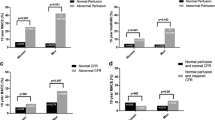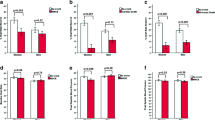Abstract
This study evaluated the gender related long-term prognostic value of adenosine perfusion and dobutamine wall motion imaging as assessed during a combined single-session stress cardiac magnetic resonance (CMR) examination. In 717 patients a combined CMR stress examination was performed. Inducible perfusion deficits and wall motion abnormalities were identified visually. Clinical parameters were assessed at the time of the CMR examination. All patients were contacted to determine the occurrence of hard cardiac events (cardiac death, myocardial infarction) during a median follow-up period of 5.3 years. A complete combined CMR examination and follow-up data were available in 679 patients (471 men). A total of 77 hard cardiac events (63 in men) occurred during follow-up. Multivariate analysis revealed the presence of inducible perfusion deficits or wall motion abnormalities as independent predictors of hard cardiac events for both gender with an incremental value over conventional cardiovascular risk factors. In case of a negative stress test result, event-free survival was 100% in women for 4 years and >99% in men for 2 years after the CMR examination. CMR perfusion and wall motion testing are equally suited for cardiac risk stratification in men and women. Stress CMR negative women exhibited very low event rates up to 4 years following the examination, while in men annual event rates increased after the second year. Consequently, the generally proposed 2-year warranty period of non-invasive stress testing may be prolonged to a 4 year level in CMR stress testing negative women.




Similar content being viewed by others
References
Roger VL, Jacobsen SJ, Pellikka PA, Miller TD, Bailey KR, Gersh BJ (1998) Gender differences in use of stress testing and coronary heart disease mortality: a population-based study in Olmsted County, Minnesota. J Am Coll Cardiol 32(2):345–352
Roger VL, Pellikka PA, Bell MR, Chow CW, Bailey KR, Seward JB (1997) Sex and test verification bias. Impact on the diagnostic value of exercise echocardiography. Circulation 95(2):405–410
Botvinick EH (1988) Breast attenuation artifacts in Tl-201 scintigraphy. Radiology 168(3):878–879
Hansen CL, Crabbe D, Rubin S (1996) Lower diagnostic accuracy of thallium-201 SPECT myocardial perfusion imaging in women: an effect of smaller chamber size. J Am Coll Cardiol 28(5):1214–1219
Marwick T, D’Hondt AM, Baudhuin T, Willemart B, Wijns W, Detry JM, Melin J (1993) Optimal use of dobutamine stress for the detection and evaluation of coronary artery disease: combination with echocardiography or scintigraphy, or both? J Am Coll Cardiol 22(1):159–167
Secknus MA, Marwick TH (1997) Influence of gender on physiologic response and accuracy of dobutamine echocardiography. Am J Cardiol 80(6):721–724
Gebker R, Jahnke C, Hucko T, Manka R, Mirelis JG, Hamdan A, Schnackenburg B, Fleck E, Paetsch I (2010) Dobutamine stress magnetic resonance imaging for the detection of coronary artery disease in women. Heart 96(8):616–620
Klem I, Greulich S, Heitner JF, Kim H, Vogelsberg H, Kispert EM, Ambati SR, Bruch C, Parker M, Judd RM, Kim RJ, Sechtem U (2008) Value of cardiovascular magnetic resonance stress perfusion testing for the detection of coronary artery disease in women. JACC Cardiovasc Imaging 1(4):436–445
Paetsch I, Jahnke C, Wahl A, Gebker R, Neuss M, Fleck E, Nagel E (2004) Comparison of dobutamine stress magnetic resonance, adenosine stress magnetic resonance, and adenosine stress magnetic resonance perfusion. Circulation 110(7):835–842
Jahnke C, Nagel E, Gebker R, Kokocinski T, Kelle S, Manka R, Fleck E, Paetsch I (2007) Prognostic value of cardiac magnetic resonance stress tests: adenosine stress perfusion and dobutamine stress wall motion imaging. Circulation 115(13):1769–1776
Cerqueira MD, Weissman NJ, Dilsizian V, Jacobs AK, Kaul S, Laskey WK, Pennell DJ, Rumberger JA, Ryan T, Verani MS (2002) Standardized myocardial segmentation and nomenclature for tomographic imaging of the heart: a statement for healthcare professionals from the Cardiac Imaging Committee of the Council on Clinical Cardiology of the American Heart Association. Circulation 105(4):539–542
Thiele H, Paetsch I, Schnackenburg B, Bornstedt A, Grebe O, Wellnhofer E, Schuler G, Fleck E, Nagel E (2002) Improved accuracy of quantitative assessment of left ventricular volume and ejection fraction by geometric models with steady-state free precession. J Cardiovasc Magn Reson 4(3):327–339
Curzen N, Patel D, Clarke D, Wright C, Mulcahy D, Sullivan A, Holdright D, Fox K (1996) Women with chest pain: is exercise testing worthwhile? Heart 76(2):156–160
Sketch MH, Mohiuddin SM, Lynch JD, Zencka AE, Runco V (1975) Significant sex differences in the correlation of electrocardiographic exercise testing and coronary arteriograms. Am J Cardiol 36(2):169–173
Mieres JH, Shaw LJ, Arai A, Budoff MJ, Flamm SD, Hundley WG, Marwick TH, Mosca L, Patel AR, Quinones MA, Redberg RF, Taubert KA, Taylor AJ, Thomas GS, Wenger NK (2005) Role of noninvasive testing in the clinical evaluation of women with suspected coronary artery disease: consensus statement from the Cardiac Imaging Committee, Council on Clinical Cardiology, and the Cardiovascular Imaging and Intervention Committee, Council on Cardiovascular Radiology and Intervention, American Heart Association. Circulation 111(5):682–696
Biagini E, Elhendy A, Bax JJ, Rizzello V, Schinkel AF, van Domburg RT, Kertai MD, Krenning BJ, Bountioukos M, Rapezzi C, Branzi A, Simoons ML, Poldermans D (2005) Seven-year follow-up after dobutamine stress echocardiography: impact of gender on prognosis. J Am Coll Cardiol 45(1):93–97
Cortigiani L, Dodi C, Paolini EA, Bernardi D, Bruno G, Nannini E (1998) Prognostic value of pharmacological stress echocardiography in women with chest pain and unknown coronary artery disease. J Am Coll Cardiol 32(7):1975–1981
Marwick TH, Shaw LJ, Lauer MS, Kesler K, Hachamovitch R, Heller GV, Travin MI, Borges-Neto S, Berman DS, Miller DD (1999) The noninvasive prediction of cardiac mortality in men and women with known or suspected coronary artery disease. Economics of Noninvasive Diagnosis (END) Study Group. Am J Med 106(2):172–178
Shaw LJ, Iskandrian AE (2004) Prognostic value of gated myocardial perfusion SPECT. J Nucl Cardiol 11(2):171–185
Shaw LJ, Vasey C, Sawada S, Rimmerman C, Marwick TH (2005) Impact of gender on risk stratification by exercise and dobutamine stress echocardiography: long-term mortality in 4234 women and 6898 men. Eur Heart J 26(5):447–456
Wallace EL, Morgan TM, Walsh TF, Dall’Armellina E, Ntim W, Hamilton CA, Hundley WG (2009) Dobutamine cardiac magnetic resonance results predict cardiac prognosis in women with known or suspected ischemic heart disease. JACC Cardiovasc Imaging 2(3):299–307
Bingham SE, Hachamovitch R (2011) Incremental prognostic significance of combined cardiac magnetic resonance imaging, adenosine stress perfusion, delayed enhancement, and left ventricular function over preimaging information for the prediction of adverse events. Circulation 123(14):1509–1518
Conflict of interest
None.
Author information
Authors and Affiliations
Corresponding author
Rights and permissions
About this article
Cite this article
Jahnke, C., Furundzija, V., Gebker, R. et al. Gender-based prognostic value of pharmacological cardiac magnetic resonance stress testing: head-to-head comparison of adenosine perfusion and dobutamine wall motion imaging. Int J Cardiovasc Imaging 28, 1087–1098 (2012). https://doi.org/10.1007/s10554-011-9919-x
Received:
Accepted:
Published:
Issue Date:
DOI: https://doi.org/10.1007/s10554-011-9919-x




